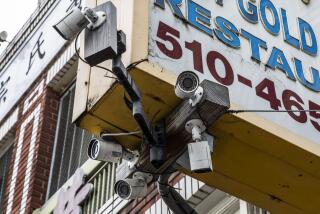Video ‘Jail’ Keeps Guard on Maryland County’s Repeat Drunk-Driving Offenders
- Share via
ANNAPOLIS, Md. — Repeat drunk drivers convicted in a new program are being allowed to keep their jobs, but as soon as the whistle blows they must go home, stay home and stay sober. Big Brother will be watching--and calling.
Anne Arundel County has invested $15,000 in 30 video monitoring systems, which are installed in offenders’ homes and linked by telephone lines to a master control in the county jail.
Under the program launched Jan. 26, offenders are not watched all the time, but they never know when a jail officer will call and ask them to step before the camera.
“A lot of people say I got off easy, but you’re stopped in your tracks at the front door,” said one of the first four men sentenced under the program, a three-time offender who agreed to be interviewed on condition that his name not be used. “It’s not exactly a slap on the wrist, but it’s better than sitting in jail.”
For this offender, the hardest part of the program is turning over $336 a month--one-fourth of his salary--to the county during his 90-day sentence. “It’s a big dent in our pocket,” said his wife.
An operator at the the jail dials each offender once, and often twice, a night and instructs him to turn on the video equipment and stand in front of the camera.
The county also has purchased hand-held breath analyzers to make sure that the offender is complying with a judge’s no-drinking stipulation. The equipment displays alcohol levels in bright red numerals that can be read over the TV monitor.
House detainees also are required to turn over one-quarter of their take-home pay to the county. If an offender’s home doesn’t have an adequate telephone jack, he has to pay for one.
Violation of any condition brings a jail sentence.
John Sellers, government marketing coordinator for Mitsubishi Electric, said the VisiTel system has been used in several states to monitor probationers, but he said Anne Arundel County is apparently the first to use the system as an alternative to prison sentences.
At least 11 manufacturers are marketing systems, according to the National Institute of Justice.
The program has been endorsed by the local chapter of Mothers Against Drunk Driving. Jean Heald, president of the group, said that when the program is combined with an alcohol counseling program it may help make highways safer.
“We’re hopeful. Sending them to jail we know doesn’t work,” said Heald, who said the program is in keeping with a philosophy of “punishment for the crime, treatment for the disease and monitoring for the citizen.”
County officials plan to review the program in the next few weeks and decide whether to buy 90 additional monitors this summer.
District Judge Thomas J. Curley said drug users, petty thieves and those convicted of minor battery charges are also likely candidates for house detention.
Asked if he expects public opposition, Curley was frank: “Are you kidding? Nothing is ever tough enough for them. But I have to live in the real world.”
House detention is an alternative to paying up to $40 a day to keep a prisoner in the county jail, as well as putting off the cost of constructing new prisons.
“There simply isn’t enough room in the detention center to lock everyone up,” said Curley.
Electronically enforced home-detention programs have expanded rapidly since the first reported test in Albuquerque, N.M., in 1983.
As of last February, according to the National Institute of Justice, an arm of the U.S. Justice Department, 53 house-detention programs in 21 states were electronically monitoring more than 800 offenders.
More to Read
Sign up for Essential California
The most important California stories and recommendations in your inbox every morning.
You may occasionally receive promotional content from the Los Angeles Times.













